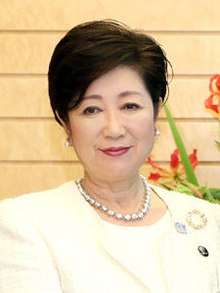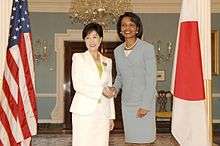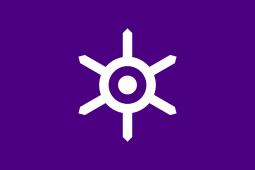Yuriko Koike
Yuriko Koike (小池 百合子, Koike Yuriko, born 15 July 1952) is a Japanese politician who currently serves as the governor of Tokyo. She graduated from Cairo University (B.A. in Sociology) as the top student in 1976 and was a member of the House of Representatives of Japan from 1993 to 2016 (when she resigned to run in the Tokyo gubernatorial election), and was previously the Minister of Defense in the cabinet of Prime Minister Shinzō Abe, but resigned in August 2007 after only 54 days in office.[1] On 31 July 2016, Koike was elected Governor of Tokyo, the city's first female governor.[2]
Yuriko Koike | |
|---|---|
小池 百合子 | |
 | |
| Governor of Tokyo | |
| Assumed office 1 August 2016 | |
| Preceded by | Yōichi Masuzoe |
| Minister of Defense | |
| In office 4 July 2007 – 27 August 2007 | |
| Prime Minister | Shinzō Abe |
| Preceded by | Fumio Kyūma |
| Succeeded by | Masahiko Kōmura |
| Minister of State for Okinawa and Northern Territories Affairs | |
| In office 27 September 2004 – 26 September 2006 | |
| Prime Minister | Junichirō Koizumi |
| Preceded by | Toshimitsu Motegi |
| Succeeded by | Sanae Takaichi |
| Minister of the Environment | |
| In office 22 September 2003 – 26 September 2006 | |
| Prime Minister | Junichirō Koizumi |
| Preceded by | Shunichi Suzuki |
| Succeeded by | Masatoshi Wakabayashi |
| Member of the House of Representatives for Tokyo's 10th district | |
| In office 11 September 2005 – 30 August 2009 | |
| Preceded by | Kōki Kobayashi |
| Succeeded by | Takako Ebata |
| Personal details | |
| Born | 15 July 1952 Ashiya, Hyōgo, Japan |
| Political party | Tomin First (2017–present) |
| Other political affiliations | JNP (Before 1994) NFP (1994–1997) LP (1997–2000) NCP (2000–2003) LDP (2003–2017) Kibō (2017–2018) |
| Alma mater | Kwansei Gakuin University American University in Cairo Cairo University |
| Website | Official website |
Early life and education
Born and raised in Ashiya, Hyōgo, a wealthy, small, city near Kobe, Koike went to Kōnan Girls' Junior and Senior High School for her secondary education. Her father, Yūjirō Koike, was a foreign trade merchant who handled oil products. He was also involved in politics, supporting Shintarō Ishihara and the Tatenokai in the 1960s, and ran unsuccessfully for national election in 1969.[3] Yūjirō emphasised to Yuriko that it was essential for Japan to strengthen relations with Arab countries to ensure a stable petroleum supply to prevent Japan being thrust into an oil war again the future. After dropping out of Kwansei Gakuin University's School of Sociology in September 1971, she went on to study Arabic at the American University in Cairo and received a Bachelor of Arts in Sociology as the top student from Cairo University in October 1976[3][4]. When she was 21, she married a fellow Japanese student but divorced soon after.[5][6] She began to work as an interpreter of Arabic and later became a journalist, interviewing Muammar Gaddafi and Yasser Arafat in 1978,[7] and becoming a news anchor in 1979. She received the Female Broadcaster of Japan award in 1990.
Career in politics

Koike was elected to the House of Councillors in 1992 as a member of the Japan New Party. She was then elected to the House of Representatives in 1993, representing the Hyogo 2nd district. In 1996, she was re-elected to the House of Representatives, this time representing the Hyogo 6th district for the New Frontier Party. She held this seat in the 2000 election as a candidate of the New Conservative Party. She joined the Liberal Democratic Party in 2002.[9] She also has been a regular contributor to Project Syndicate since 2010.
Cabinet service (2003-2007)
She served as the Minister of the Environment and Minister of State for Okinawa and Northern Territories Affairs in the Cabinet of Prime Minister Jun'ichirō Koizumi. Along with Satsuki Katayama and Makiko Fujino, Koike became known as one of Koizumi's "assassins" in the 2005 Lower House election, running in Tokyo against an LDP hardliner candidate who opposed Koizumi's policies.[10]
She was appointed the first female Minister of Defense in June 2007 during the first term of Prime Minister Shinzo Abe, but announced in August 2007 that she intended to resign from the post, citing the Aegis classified information leak scandal as a reason.[1] Koike later hinted that the much-publicized fight she had had with Chief Cabinet Secretary Yasuhisa Shiozaki over a vice-minister replacement was the real reason, as the opposition would use that to oppose a bill on Japan's terrorism laws.[11]
2008 LDP leadership election
On 8 September 2008, she launched her bid to become president of the LDP and became the first woman ever to seek the premiership in Japan's history: "I have received the enthusiastic support of my colleagues. In order to break through the deadlock facing Japanese society, I believe the country might as well have a female candidate. Hillary used the word 'glass ceiling' ... but in Japan, it isn't glass, it's an iron plate. I'm not Mrs. Thatcher, but what is needed is a strategy that advances a cause with conviction, clear policies and sympathy with the people."[12] In the leadership election, held on 22 September, Tarō Asō won with 351 of the 527 votes; Koike placed third with 46 votes.[13]
Governor of Tokyo (2016–present)
Following the resignation of Tokyo governor Naoki Inose in December 2013, Koike was widely rumored to be a potential candidate for the gubernatorial election expected to be held in February 2014, along with Hideo Higashikokubaru, Hakubun Shimomura, Seiko Hashimoto and Yōichi Masuzoe.[14] She ultimately did not run, and Masuzoe won.
After Masuzoe announced his resignation in June 2016, Koike announced her intention to run in the election for his successor. Koike stated that she would run "as an LDP lawmaker" but did not obtain the approval of the Tokyo LDP chapter before announcing her candidacy.[15] The LDP officially endorsed Hiroya Masuda, and its Tokyo chapter issued a notice that any members supporting Koike would be punished. Nonetheless, several prominent LDP politicians continued to back Koike, while senior leaders such as Shinzo Abe refrained from making speeches in support of either candidate.[16]
Koike was elected Governor of Tokyo on 31 July 2016, becoming the first woman in the post.[17]
On August 21, 2016, at the 2016 Summer Olympics closing ceremony, Koike received the Olympic Flag, via Thomas Bach, from the mayor of Rio de Janeiro, Eduardo Paes.
On 31 May 2017, in advance of the upcoming local elections, Koike resigned from the Liberal Democratic Party and officially became the leader of Tomin First no Kai (Tokyoites First). Koike founded the group in 2016 in preparation for the elections and formed an alliance with Komeito in an effort to secure a governing majority in Tokyo's parliament.[18] On July 3, 2017, the alliance took a majority in the prefectural election, pushing out the Liberal Democratic Party with a combined 79 seats of the 127-seat assembly.[19]
Political positions
Koike supports economic liberalism, promotes administrative and budgetary reform, and insists on further advancement of the status of women in the working world. In promising the pursuit of women-friendly policies, she has stated, "I believe that pushing policies for women will be good for Tokyo and bring happiness to the capital." Her stated basic principles and stance regarding political reform are encompassed by "The 5 Cs: Check, Challenge, Change, Creative and Communication".[20] In terms of the economy, she has used for aggressive privatization of Japanese assets to diminish the government's debt burden. A strong turn towards IT development, natural sciences, sustainable infrastructure, and efficiency-based administrative reforms for public services were also on the docket.[21]
Environmentalism
Having learned an environmental way of life from her own experience of wartime austerities in Egypt,[4] Koike addresses environmental issues. She expressed the idea of introducing a carbon tax in 2005 so that Japan might achieve the goals of the Kyoto Protocol.[22] The next year, she inaugurated the "Mottainai Furoshiki" campaign, which urges shoppers to use furoshiki in place of plastic shopping bags.[23] She is against the use of biofuels made from food crops.[24]
Conservative nationalism
As a conservative nationalist, she belonged to the Diet members' league to support the Japanese Society for History Textbook Reform.[25][26] Koike was one of the five vice secretaries general of the Diet Members' Committee of Nippon Kaigi, the country's largest conservative think tank and the main nationalist lobby, once chaired by Tarō Asō. She is also known to have powerful ties to large conservative political groups, like the Japan Conference.
She was a member of the Diet members' group to promote Yasukuni Shrine visits, led by Yoshinobu Shimamura, and goes to pay her respects to the war dead at the shrine on War-End Day, 15 August, almost every year.[26] Not being able to visit in 2007 due to an official trip to Okinawa, she sent her proxy.[27][28][29]
Position on Article 9
Her foreign and security policies are often regarded as hawkish.[8][26][30] She suggested that the prime minister revise the interpretation of Article 9 of the Constitution of Japan to enable the government to exercise the right to collective self-defense.[26][31]
She has supported the United States and the War on Terror and opposes the Japanese government's tradition of UN-centered foreign policy.[32] However, she has sent mixed messages to the United States in terms of destabilizing the Middle East with democratization efforts. On the other hand, showing parts of the world how powerful the United States is as an ally is a priority. During the 2008 LDP leadership election, she pledged to make Russia return the four disputed islands to Japan if she was elected as prime minister. Overall, Koike is a diplomatic leader. Back in 2010, she helped strengthen ties between Libya's Muammar Quaddafi and Japan. This led to the creation of the Japan-Libya Friendship Association.[33]
Other positions
Koike has also actively promoted Japanese pop culture, appearing in cosplay as Sally from Sally the Witch in 2015, and stating during her 2016 Tokyo gubernatorial campaign that she wanted to turn all of Tokyo into an "anime land".[34]
Koike initiated "Jisa Biz" (時差biz) in July 2017 to promote telecommuting and staggered work times to reduce congestion during the morning rush hour in Tokyo.[35]
In 2017, Koike launched and led a new national political party. It was called Kibō no Tō, which means "Party of Hope". Although still Governor of Tokyo, she was the primary leader of this party. It was assumed that this party could have been the main opposition to the LDP. On October 22, 2017, the Party of Hope did not perform as well at the polls as expected. Koike's overarching policies were similar to those of current Prime Minister Shinzo Abe. The policy to set them apart was their differing opinions on nuclear energy. Koike was opposed to it as an advocate of the environment.[36] Koike did not join any successor party to the Party of Hope at its April 2018 dissolution.
References
- Koike decides to leave post, cites responsibility over information leak Archived June 11, 2015, at the Wayback Machine, JapanNewsReview.com; accessed 18 June 2015.
- Landers, Peter (July 31, 2016). "Yuriko Koike Elected Governor of Tokyo, First Woman in Post". Retrieved December 26, 2016 – via Wall Street Journal.
- "Oyaji no Senaka", Asahi Shimbun Morning Edition, 24 August 2008.
- "Kikase te Anata no Mottainai", Shufu-to-Seikatsusha, 12 September 2006.
- Masaharu Fujiyoshi. "Koike Yuriko Kenkyū", Shūkan Bunshun, Bungeishunjū, 20 October 2005.
- "Koike Yuriko Fūin no Nijūissai", Flash, vol. 1020, Kobunsha, September 2008.
- "10 things about Tokyo's new governor Yuriko Koike". The Straits Times. August 1, 2016.
- "'Japan's Condi Rice' known for courting controversy", The Japan Times, 5 July 2007.
- "プロフィール | 小池ゆりこ オフィシャルサイト". www.yuriko.or.jp. Archived from the original on July 22, 2016. Retrieved July 20, 2016.
- Faiola, Anthony (September 3, 2005). "In Japan, the Lipstick Ninjas Get Out the Vote". The Washington Post. ISSN 0190-8286. Retrieved July 20, 2016.
- "Resigning Koike criticizes opposition" Archived August 16, 2016, at the Wayback Machine, JapanNewsReview.com; accessed 18 June 2015.
- Japan PM contender sees "iron" barrier for women, reuters.com; accessed 18 June 2015.
- "Aso elected LDP head", yomiuri.co.jp, 22 September 2008.
- "猪瀬知事が辞職表明「都政を停滞させられない」". 日本経済新聞. December 19, 2013. Retrieved December 20, 2013.
自民党の石破茂幹事長は19日午前、東京都連幹部と協議し、年内の候補者決定を目指す方針を確認した。党内では小池百合子元防衛相や下村博文文部科学相、橋本聖子参院議員らの名前が取り沙汰されている。7月の参院選への出馬を見送った元新党改革代表の舛添要一氏、日本維新の会を離党して衆院議員を辞職した東国原英夫氏らの名前も浮上している。
- "LDP's Koike prepared to run in Tokyo governor's race". The Asahi Shimbun. June 29, 2016. Retrieved July 20, 2016.
- "Ruling camp keeps low profile in Tokyo race". The Yomiuri Shimbun. July 19, 2016. Retrieved July 20, 2016.
- "Yuriko Koike Elected Governor of Tokyo, First Woman in Post". The Wall Street Journal. July 31, 2016.
- hermes (June 2, 2017). "Tokyo Governor Yuriko Koike quits LDP to lead own party to polls". The Straits Times. Retrieved June 2, 2017.
- Shimbun, The Yomiuri. "Koike camp gets majority". The Japan News. Archived from the original on July 5, 2017. Retrieved July 5, 2017.
- Koike Yuriko Kihon Rinen Archived August 6, 2016, at the Wayback Machine Koike Yuriko official website.(in Japanese)
- "Koike pledges to push carbon tax to meet goals under Kyoto Protocol", japantimes.co.jp, 6 November 2005.
- "Minister Koike created the 'Mottainai Furoshiki'", env.go.jp; accessed 18 June 2015.
- Mainichi Shimbun Morning Edition, 11 March 2008.
- "Uha no Sokkin de Katamerareta Abe Seiken" Archived July 22, 2011, at the Wayback Machine, chosunonline.com, 27 September 2006.(in Japanese)
- "'Yasukuni Shikan' Kataru Menmen", Akahata, 6 October 2006. (in Japanese)
- "Koike Daijin Kaiken Gaiyō", 7 August 2007.(in Japanese)
- Yasukuni Sampaisha List 2007", kinyobi.co.jp; accessed 18 June 2015.(in Japanese)
- "Sōsaisen Yasukuni demo Zessen", Sankei Shimbun, headlines.yahoo.co.jp, 15 September 2008.(in Japanese)
- "Chūgokushi 'Koike Shin Bōeishō wa Takaha no Seijika'", Nippon News Network, 4 July 2007.(in Japanese)
- "Nippon ga Dekiru Keizai Seisai", Voice, April 2003.(in Japanese)
- "Ozawa Ichirō to Koizumi Junichirō o Kiru Archived September 14, 2008, at the Wayback Machine", yuriko.or.jp, January 2008.(in Japanese)
- "Dōshūsei Dōnyū ni Iyoku", Chugoku Shimbun, 15 September 2008.(in Japanese)
- Ashcraft, Brian. "Let's Turn Tokyo Into Anime Land, Says Politician". Retrieved July 20, 2016.
- Shimbun, The Yomiuri. "'Jisa Biz' campaign to start Tuesday". The Japan News. Retrieved July 11, 2017.
- Koike, Yuriko. "New National Political Party Announced". NHK World News. Retrieved September 25, 2017.
External links
- Koike Yuriko Official Website
- Prime Minister of Japan and His Cabinet – Profile
- Yuriko Koike appointed new Defense Minister
| Wikimedia Commons has media related to Yuriko Koike. |
| House of Representatives of Japan | ||
|---|---|---|
| Preceded by Multi-member |
Member of the House of Representatives for Hyōgo's 2nd district Multi-member 1993–1996 |
Constituency abolished |
| New constituency | Member of the House of Representatives for Hyōgo's 6th district 1996–2003 |
Kōichirō Ichimura |
| Preceded by Proportional representation |
Member of the House of Representatives for Kinki 2003–2005 |
Succeeded by Proportional representation |
| Preceded by Kōki Kobayashi |
Member of the House of Representatives for Tokyo's 10th district 2005–2009 |
Succeeded by Takako Ebata |
| Preceded by Proportional representation |
Member of the House of Representatives for Tokyo 2009–2016 |
Succeeded by Proportional representation |
| Political offices | ||
| Preceded by Shunichi Suzuki |
Minister of the Environment 2003–2006 |
Succeeded by Masatoshi Wakabayashi |
| Preceded by Toshimitsu Motegi |
Minister of State for Okinawa and Northern Territories Affairs 2004–2006 |
Succeeded by Sanae Takaichi |
| Preceded by Fumio Kyūma |
Minister of Defense 2007 |
Succeeded by Masahiko Kōmura |
| Preceded by Yōichi Masuzoe |
Governor of Tokyo 2016–present |
Incumbent |

